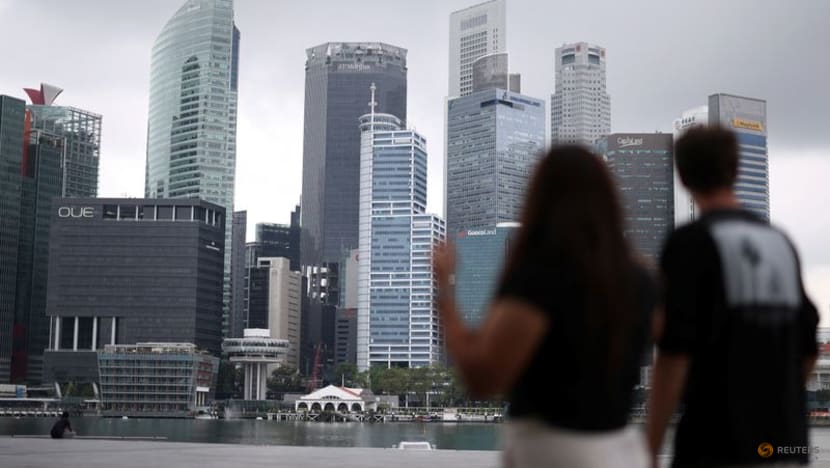Singapore upgrades 2025 GDP growth forecast to 1.5%-2.5%; economy grew 4.4% in Q2
The growth forecast was previously between 0 per cent and 2 per cent.

A view of the central business district in Singapore. (File photo: Reuters/Edgar Su)

This audio is generated by an AI tool.
SINGAPORE: The Ministry of Trade and Industry (MTI) has upgraded Singapore's gross domestic product (GDP) growth forecast for the year to 1.5 per cent to 2.5 per cent, up from 0 per cent to 2 per cent previously.
On Tuesday (Aug 12), MTI announced the narrowed forecast and said it largely reflects the better-than-expected performance of the Singapore economy in the first half of 2025.
The ministry said the Singapore economy grew 4.4 per cent in the second quarter of the year, a slight upgrade from the advance estimate of 4.3 per cent. GDP growth for the first quarter was 4.1 per cent.
For the first half of the year, Singapore's GDP growth came in at 4.3 per cent when compared with the previous year.
This is the second time this year that the ministry is changing its growth forecast for 2025. The forecast was initially for growth of 1 per cent to 3 per cent, but was downgraded in April after US President Donald Trump announced a global baseline tariff of 10 per cent and reciprocal tariffs on many other economies.
But a 90-day pause in the reciprocal tariffs led to the performance of most advanced and regional economies to be "more resilient than expected", said MTI said in its latest Economic Survey of Singapore.
The potential negative economic impact was postponed, and frontloading provided a "temporary boost to production and exports".
MTI also noted that there has been a deescalation in trade tensions, with the US reaching trade deals with trading partners such as the Eurozone, Japan, South Korea and several Southeast Asian economies. The tariff truce between the US and China has also been extended by 90 days.
The growth forecast takes into account the good performance of the first six months of the year as well as the projected softening of global and domestic economies in the second half of 2025, said MTI.
"Singapore’s economic outlook for the rest of the year remains clouded by uncertainty, with the risks tilted to the downside," the ministry said.
"MTI will continue to monitor developments in the global and domestic economies closely, and make adjustments to the forecast if necessary over the course of the year."
Responding to a question about the US's tariffs on transshipped goods and how it might affect Singapore, MTI permanent secretary Beh Swan Gin said the definition used by US is different from the way other countries, including Singapore, typically use the term.
"So at this point, I really wouldn't want to speculate how the the US's proposed measures against their interpretation of transshipment will affect our sectors," he said during a media briefing.
MTI chief economist Yong Yik Wei said the sectors involved in transshipped goods include wholesale trade, transport and storage.
The water transport sector, including port activity and shippers, as well as the air transport sector, such as air cargo and freight forwarders, could also be involved, she added.
Dr Beh also responded to a question on whether there could be a technical recession this year.
"At this point, we can't speculate on that. The numbers that you see, 1.5 to 2.5 (per cent), these imply a slowdown from the numbers that we experienced in the first half of 2025," he said.
"But I think it will be a little bit premature to speculate whether there will be a technical recession or not."
GLOBAL ECONOMIC OUTLOOK
The GDP growth of key economies is likely to be better than earlier projections, but is expected to moderate from the first half of the year, said MTI.
Economic growth in the US is expected to weaken given signs of a cooling labour market, and consumer spending is likely to be dampened as prices rise due to tariff hikes.
The Eurozone's exports could weaken as tariffs take effect, though easing trade tensions could improve economic sentiments, while lower inflation and accommodative monetary policy could provide some support to domestic demand.
For China, exports growth is also expected to soften as global trade activity is subdued by US tariffs, though domestic consumption and investment growth are projected to remain firm. Southeast Asian economies will be affected by the US tariffs as well.
"Significant uncertainties remain in the global economy due in part to the continued unpredictability of the US’ trade policies, including the timing and extent of the sectoral tariffs on pharmaceutical products and semiconductors," said MTI, highlighting three risks.
The first is that tariffs re-escalate, leading to a new spike in economic uncertainty, which could cause businesses and households to pull back on spending and hiring.
The second risk is that a sharper-than-expected tightening of global financial conditions leads to "destabilising capital flows" that trigger vulnerabilities in banking and financial systems.
The third risk is for potential escalations in geopolitical tensions to lead to a disruption in the supply of energy commodities, and renew pressures on global energy prices.
For Singapore, slower growth in outward-oriented sectors is expected to dampen economic activity in the second half of the year.
The manufacturing sector, in particular, is likely to be hit by US tariffs, while the wholesale trade sector is similarly expected to slow. The softening in global trade and waning of frontloading will also weigh on the transportation and storage sector.
Fragile business confidence and tepid consumer spending will also likely dampen growth in the finance and insurance sector. Consumer-facing sectors could remain lacklustre, weighed down by the continued shift in locals' spending abroad and the projected weakening of domestic labour market conditions.
SECOND QUARTER PERFORMANCE
Growth in the April to June period was driven primarily by the wholesale trade, manufacturing, finance and insurance, and transportation and storage sectors.
The wholesale trade sector grew 4.7 per cent compared with a year ago, up from 4 per cent in the first quarter of the year. The machinery, equipment and supplies segment expanded because of robust growth in the wholesale volumes of electronic components and telecommunications and computers.
The fuels and chemicals segment grew due to an increase in the wholesale sales of petroleum and petroleum products. On a quarter-on-quarter seasonally adjusted basis, the sector grew by 2.8 per cent, a turnaround from the 0.5 per cent contraction in the first quarter.
The manufacturing sector grew 5.2 per cent from a year ago, up from 4.7 per cent in the first quarter of the year. Output from all clusters except chemicals and general manufacturing increased. On a quarter-on-quarter seasonally adjusted basis, the sector shrank by 0.4 per cent, compared with the 5.2 per cent contraction in the preceding quarter.
The food and beverage services sector, however, shrank in part because of a sustained increase in outbound travel by locals. The sector shrank 0.5 per cent from a year ago, having already contracted 0.7 per cent in the previous quarter.
The weak performance was due to a fall in sales volumes at restaurants and fast-food outlets, which more than offset an increase in sales volumes at food caterers and cafes, food courts and other eating places. On a quarter-on-quarter seasonally adjusted basis, the sector contracted by 0.7 per cent, extending the 0.6 per cent decline in the first three months of the year.
NON-OIL DOMESTIC EXPORTS
In a separate media release on Tuesday, Enterprise Singapore said Singapore's non-oil domestic exports (NODX) grew 7.1 per cent in the second quarter of the year, up from 3.3 per cent in the January to March period.
Electronics exports grew 10.5 per cent in the second quarter, with personal computers, semiconductors and disk media products being key contributors.
Non-electronic products exports grew 6 per cent, compared with 1.8 per cent in the first quarter.
"The largest contributors to the increase were non-monetary gold, specialised machinery and structures of ships and boats," said EnterpriseSG.
The NODX forecast for the year remains at 1 per cent to 3 per cent.
"The lower bound of the forecast builds in a weaker profile for 2H 2025 following stronger-than-expected 1H 2025 NODX growth," the agency said.
As frontloading activities taper and reciprocal tariffs take effect, these could weigh on global economic activity and trade, EnterpriseSG said.
It added that the evolving tariff situation and continued economic uncertainty could dampen demand, and sector-specific tariff risks remain.














